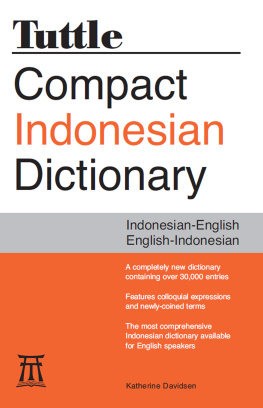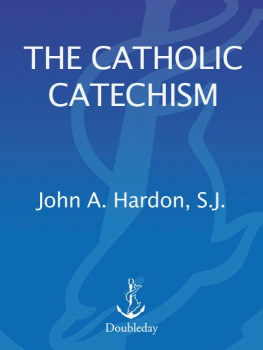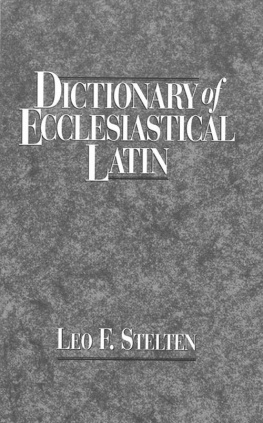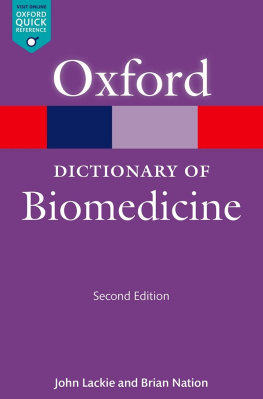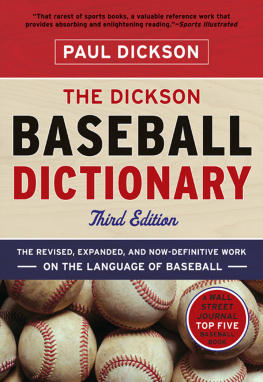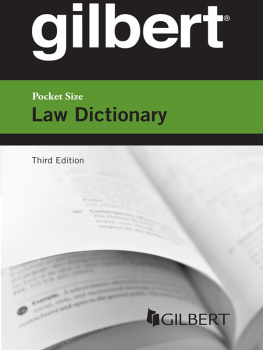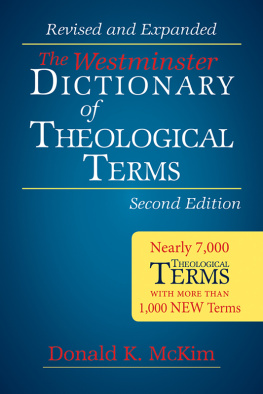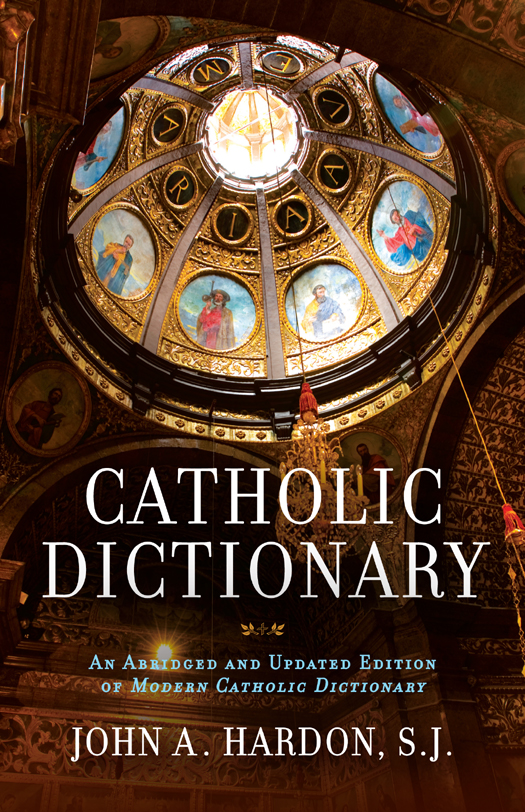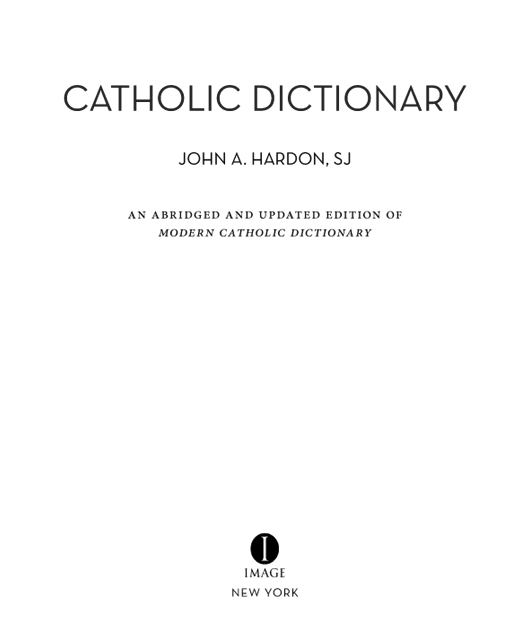An Image Book
Copyright 1980 by John A. Hardon
New material copyright 2013 by Inter Mirifica
Excerpts from The Jerusalem Bible, copyright 1966 by Darton, Longman & Todd, Ltd., and Doubleday & Company, Inc. Used by permission of the publisher.
1980 Edition:
Imprimi Potest:
Michael J. Lavelle, S.J.
Provincial, Detroit Province
December 3, 1979
Nihil Obstat:
William B. Smith, S.T.D.
Censor Librorum
Imprimatur:
Joseph T. OKeefe
Vicar General, Archdiocese of New York
December 13, 1979
Updated 2013 Edition:
Nihil Obstat:
Monsignor Francis J. McAree, S.T.D.
Imprimatur:
Bishop Gerald T. Walsh, Archdiocese of
New York
March 19, 2013
The Nihil Obstat and Imprimatur are official declarations that this book is free of doctrinal or moral error. No implication is contained therein that those who have granted the Nihil Obstat and Imprimatur agree with the content, opinions, or statements expressed.
All rights reserved.
Published in the United States by Image Books, an imprint of the Crown Publishing Group, a division of Random House, Inc., New York.
Image and the Image colophon are registered trademarks of Random House, Inc.
Originally published in hardcover in slightly different form as Modern Catholic Dictionary in 1980 and subsequently published as an abridged paperback edition as Pocket Catholic Dictionary in 1985 in the United States by Image Books, a division of Random House, Inc., New York.
Library of Congress Catalog Card Number: 7782945
Library of Congress Cataloging-in-Publication Data
Hardon, John A.
Modern Catholic dictionary.
1. Catholic ChurchDictionaries. 2. TheologyDictionaries. I. Title.
BX841.H36 282.03
eISBN: 978-0-307-88635-4
Cover design: Nupoor Gordon
Cover photograph: Ben Pipe/Robert Harding World Imagery/Getty Images
v3.1
CONTENTS
A NOTE ON THE 2013 EDITION
It is with great pleasure that Image books presents this updated version of the long-out-of-print Modern Catholic Dictionary, originally published to great acclaim in 1980. Though Father Hardon passed away in 2000, his prose and insight have been appreciated by the faithful and the curious for decades now. It is our hope that this updated edition will introduce this excellent book to a whole new generation of readers.
We are grateful and thankful to John OConnell, who oversaw the editing of this book. His patience, guidance, and love for the material were a blessing to us.
Gary Jansen
Senior Editor, Image Books
New York, 2013
INTRODUCTION
1980
The need for a modern Catholic dictionary seems obvious. Much has happened in the Catholic Church since the opening of the Second Vatican Council in 1962. The council itself was a historic event whose sixteen documents, confirmed by Pope Paul VI, have deeply influenced the thinking of all the faithful. As a result, new words and expressions have entered the Catholic vocabulary, and old terms have taken on a fresh and more profound meaning.
Moreover, the world in which the faithful live has undergone major changes, some would say among the most profound in Christianity since the apostolic age. Secularism is no longer a mere theory; it is the chosen way of life of large segments of Western society. Marriage and the family are on trial for their existence; abortion and now euthanasia are being legalized in one country after another. This has placed a grave strain on Catholicism, and the effects are showing across a wide spectrum of thought and practice, again with corresponding impact on the language of people who instead of the spirit of the world, as St. Paul says, have received the Spirit that comes from God.
No dictionary is ever complete, and the present one makes no claim to comprehensiveness. There are too many terms in what may be called the Catholic vocabulary to even cover them all, let alone give an extensive treatment of each one. This is plainly to be a dictionary and not an encyclopedia. Yet, unlike other lexicons, a Catholic dictionary should be more than a mere listing of definitions. It cannot, in the name of objectivity, remain neutral on things on which the Catholic Church has an established position. Otherwise it would not merit being called Catholic.
Many terms have been included from psychology and the social sciencesbut always defined (or described) from a Catholic point of view. They were included because they underlie distinctively Catholic principles, or in order to indicate how the Church understands the world in which her faithful live and are working out their salvation.
All the while, however, the main focus of the dictionary and the bulk of its contents are definably, even exclusively, Roman Catholic. An effort was made to include every significant concept of the Churchs doctrine in faith and morals, ritual and devotion, canon law and liturgy, mysticism and spirituality, ecclesiastical history and organization.
Special attention has been given to the Second Vatican Council and the most important documents that explain the conciliar teaching.
Events in the life of the Church over the centuries have been screened to include such as are necessary or at least useful for a balanced grasp of Catholic Christianity. There has endured a stable tradition that proves the Churchs divine origin and guidance. But there has also been development, and therefore change. The dictionary seeks to reflect both dimensions: the Catholic, and therefore the Churchs continuity, and the modern, and therefore her progress, in a marvelous paradox that is borne out in no other institution in the annals of the human race.
Wherever feasible, exact Scripture references or even citations have been given to enable the reader to go back to the Bible to see the defined term in its full biblical context. So, too, precise references, often with quotations, are given for the Churchs doctrines, which may then be traced to their original sources, mainly in papal documents or the canons and decrees of ecumenical councils.
Equivalent terms have not been multiplied beyond measure, but enough of them are available to help the reader find what is sought, perhaps defined under a heading different from the one that first comes to mind.
Special attention was given to Catholic shrines and prayers. With so many hallowed places of pilgrimage and forms of popular piety in the Catholic world, the author felt that these should be duly considered. They reflect one side of the Churchs existence that may be overlookednamely, the peoples sentiment and affections, with particular emphasis on their devotion to the Blessed Virgin Mary. Likewise the praying side of Catholicism has been highlighted with many of the better-known prayers and hymns. These appear with a brief history and, in most cases, the full text of the prayer or song in question.
There are really two parts to the dictionary, of unequal length. The first and major part is the lexicon of terms, over five thousand, directly or indirectly dealing with Catholic faith, worship, morals, history, canon law, and spirituality.
The second part is the Appendix, which contains the Credo of the People of God and a listing of popes from Peter to Benedict XVI.
Priests and teachers, whether in the pulpit, in the classroom, or in the home, will find in the dictionary an invaluable aid to communicating the riches and beauty of the Catholic religion. It is the authors hope that this book will bring everyone who reads it closer to the One who is beyond all definition, and for whose honor and glory it was written.


